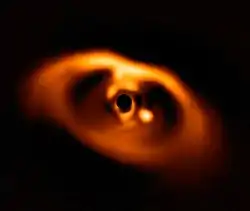Lists of exoplanets
This is a list of exoplanets. As of 28 January 2021, there are 4,341 confirmed exoplanets,[1] the majority of which were discovered by the Kepler space telescope. There are an additional 2,366 potential exoplanets from Kepler's first mission yet to be confirmed, as well as 889 from its "Second Light" mission and 1,385 from the Transiting Exoplanet Survey Satellite (TESS) mission.[2]

For yearly lists on physical, orbital and other properties, as well as on discovery circumstances and other aspects, see § Specific exoplanet lists.
Nomenclature
The convention for designating exoplanets is an extension of the system used for designating multiple-star systems as adopted by the International Astronomical Union (IAU). For exoplanets orbiting a single star, the IAU designation is formed by taking the designated or proper name of its parent star, and adding a lower case letter.[3] Letters are given in order of each planet's discovery around the parent star, so that the first planet discovered in a system is designated "b" (the parent star is considered to be "a") and later planets are given subsequent letters. If several planets in the same system are discovered at the same time, the closest one to the star gets the next letter, followed by the other planets in order of orbital size. A provisional IAU-sanctioned standard exists to accommodate the designation of circumbinary planets. A limited number of exoplanets have IAU-sanctioned proper names. Other naming systems exist.
Methods of detection
- Astrometry: 1 (0.0%)
- Direct imaging: 51 (1.2%)
- Radial velocity: 824 (19.0%)
- Transit: 3,306 (76.2%)
- Transit-timing variation: 21 (0.5%)
- Eclipse timing variation: 16 (0.4%)
- Microlensing: 106 (2.4%)
- Pulsar timing variation: 7 (0.2%)
- Pulsation timing variation: 2 (0.0%)
- Orbital brightness modulation: 6 (0.1%)
- Disk kinematics: 1 (0.0%)
About 97% of all the confirmed exoplanets have been discovered by indirect techniques of detection, mainly by radial velocity measurements and transit monitoring techniques.[4]
Specific exoplanet lists

- List of exoplanets discovered before 2000 (30)
- List of exoplanets discovered between 2000–2009 (381)
- List of exoplanets discovered in 2010 (101)
- List of exoplanets discovered in 2011 (142)
- List of exoplanets discovered in 2012 (143)
- List of exoplanets discovered in 2013 (141)
- List of exoplanets discovered in 2014 (865)
- List of exoplanets discovered in 2015 (163)
- List of exoplanets discovered in 2016 (1511)
- List of exoplanets discovered in 2017 (148)
- List of exoplanets discovered in 2018 (311)
- List of exoplanets discovered in 2019 (202)
- List of exoplanets discovered in 2020 (261)
- List of exoplanets discovered in 2021 (25)
- List of potentially habitable exoplanets
- List of proper names of exoplanets
- List of multiplanetary systems
- List of exoplanet firsts
- List of exoplanet extremes
- List of exoplanets discovered using the Kepler space telescope
- List of exoplanets observed during Kepler's K2 mission
- List of extrasolar candidates for liquid water
- List of nearest exoplanets
- List of nearest terrestrial exoplanet candidates
- List of transiting exoplanets
See also
References
- "NASA Exoplanet Archive". exoplanetarchive.ipac.caltech.edu. Retrieved 13 September 2019.
- "Exoplanet and Candidate Statistics". NASA Exoplanet Archive. NASA Exoplanet Science Institute. Retrieved 13 September 2019.
- "International Astronomical Union | IAU". www.iau.org. Retrieved 29 January 2017.
- Ollivier, Marc; Maurel, Marie-Christine (2014). "Planetary Environments and Origins of Life: How to reinvent the study of Origins of Life on the Earth and Life in the". BIO Web of Conferences 2. 2: 00001. doi:10.1051/bioconf/20140200001.
External links
- The Extrasolar Planet Encyclopaedia — Catalog Listing accessed in 2015-09-28
- Exoplanet Data Explorer accessed in 2015-09-28
- "Open Exoplanets Catalogue". Archived from the original on 2017-09-02. Retrieved 2017-02-27.
- Wright, J. T.; Fakhouri, O.; Marcy, G. W.; Han, E.; Feng, Y.; Johnson, John Asher; Howard, A. W.; Fischer, D. A.; Valenti, J. A. (2011-04-01). "The Exoplanet Orbit Database". Publications of the Astronomical Society of the Pacific. 123 (902): 412–422. arXiv:1012.5676. Bibcode:2011PASP..123..412W. doi:10.1086/659427. ISSN 0004-6280. S2CID 51769219.



